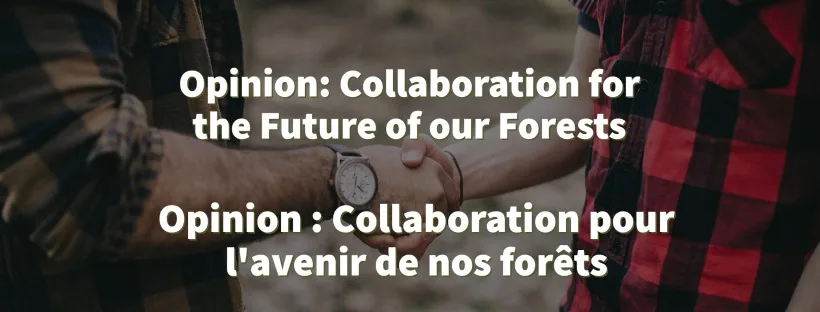Opinion: Collaboration for the Future of our Forests
We can all agree on the important role forestry plays in the economy of New Brunswick by providing jobs and income for thousands of people across the province and supporting dozens of communities around the province. The sector in New Brunswick is older than anywhere else in Canada and continues to thrive thanks to a legacy of adapting to challenges and change over time. Today the prominent issues of climate change, economic uncertainty, and prevailing public sentiment are complex and present a unique urgency not only for our sector, but for many others. Overcoming these challenges can seem daunting, but the forest sector is particularly well-positioned to do just that. Achieving effective solutions requires continued collaboration and engagement between industry, governments, and informed citizens.
Last week, I had the pleasure of attending two very different events focused on the future of forestry in the province and country. First was Envirothon NB, a middle and high school science competition where students are tested on their knowledge of forestry, aquatics, wildlife, and soils & land use, in the context of climate change adaptation and mitigation. The second was the annual forum of the Canadian Council of Forest Ministers (CCFM) where Ministers, policymakers, industry leaders, NGOs and other stakeholders met to consider and learn more about challenges, solutions, and best practices in the forest sector in Canada. While these two events discussed issues and opportunities from very different perspectives, what stood out was the agreement and optimism that our forest industry is uniquely poised to support economic development, social benefits, and relationship building, all while helping us meet climate and biodiversity goals.
What is evident is that forest strategies that satisfy the needs and values of multiple users and are developed and supported collaboratively among stakeholders, rightsholders, and industry will continue to preserve the diversity of functions, values and benefits that forests provide. It was also evident that well-managed forests amplify our conservation efforts. Other Effective Conservation Measures (OECMs) will help us achieve conservation, habitat and biodiversity goals in tandem with other conservation initiatives.
New Brunswick may be small geographically, but we are world leader in 3rd party forest certification, with roughly 71% of our total forested area certified. We are also partners the progressive Early Intervention Strategy, a collaboration between researchers, governments, industry, and the public, aimed at balancing Spruce Budworm populations and preventing catastrophic defoliation and the subsequent loss of forests. Our forest product companies are continually improving efficiencies and maximizing values both in the forest and in manufacturing of products.
When we share our successes, discuss our challenges, and meet often to exchange knowledge, we create more opportunity for growth and innovation. By collaborating on policies, implementing adaptive and sustainable practices, and by focusing on improving opportunities for all, we improve the resilience of our forests and industry, while realizing economic opportunities and biodiversity conservation goals. I am consistently inspired by the many passionate professionals across the province united in the goals of preserving and enhancing our forests for the future. The next time you take a walk through the forest, think of all those who have worked and continue to work hard to shape a bright future for our forests.

